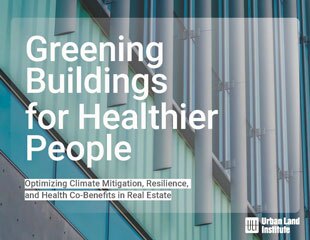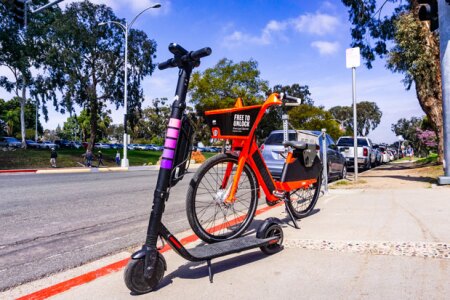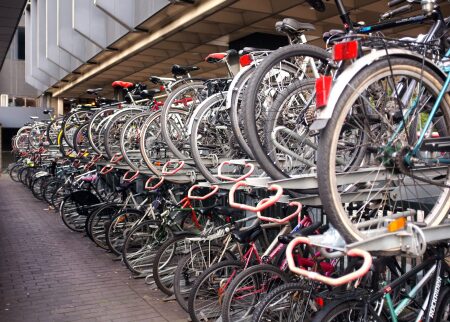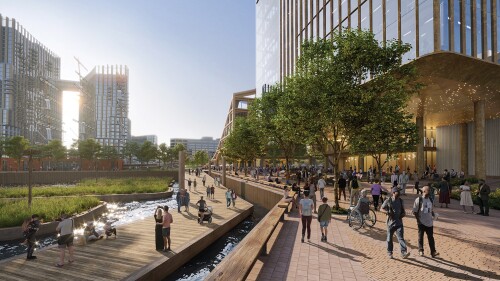ULI’s Building Healthy Places Initiative published the report Greening Buildings for Healthier People: Optimizing Climate Mitigation, Resilience, and Health Co-Benefits in Real Estate in March 2022. This three-part article series takes a closer look at some of these co-benefits and how they can promote project success locally while contributing to healthier cities, regions, and beyond. Part I: Exploring the Benefits of Low-Carbon Buildings for Climate Change and Health | Part III: Think Globally, Build Locally: Exploring the Benefits of Access to Nature for Climate Change and Health
When U.S. pandemic lockdowns were underway about two years ago, many people—especially those who could work from home—drastically reduced their driving and transit use. Although this contributed to a short-term reduction in carbon emissions, energy use has since rebounded, and some people continue to avoid public transportation in favor of less sustainable options like driving.
These trends reflect larger issues around land use and mobility in cities. Public transportation has increasingly proven to be safe from a virus standpoint, but other barriers to using transit remain: a lack of equitable access to bus stops and reliable service, entrenched land use patterns that encourage driving, and few first-mile/last-mile options for connecting to transit.
While individual development projects cannot overcome these challenges alone, they can encourage behavior and systems change by providing charging infrastructure for electric vehicles and supporting multimodal options. These strategies not only have benefits for climate mitigation but also promote health and climate resilience, as described in the new ULI report Greening Buildings for Healthier People: Optimizing Climate Mitigation, Resilience, and Health Co-Benefits in Real Estate.
The report focuses on strategies for individual buildings and sites, describing how these strategies benefit tenants and communities while advancing project success. However, these transportation-related decisions also help to shape everything from cities to the global climate; after all, transportation accounted for the largest portion (29 percent) of total U.S. greenhouse gas emissions in 2019, of which 58 percent came from light-duty vehicles like cars. And, a typical passenger vehicle emits about 4.6 metric tons of carbon dioxide per year.
At the same time, these strategies can help to promote active living, improve air quality, and enable people to easily travel for health care, all of which are essential for public health. As real estate professionals work on individual properties, they can think about the powerful intersections with mobility issues that contribute to the health and sustainability of cities—and beyond.
Optimizing the Benefits of Charging Infrastructure and Site Selection
Greening Buildings for Healthier People discusses the many benefits of providing onsite charging, site selection for healthy development patterns, and related amenities like bike storage rooms. Each of these promotes less carbon-intensive modes of transportation that can also enhance health and/or climate resilience.
Charging Infrastructure and Amenities
By supporting electric and/or active transportation options through charging infrastructure and amenities, buildings can make these choices more feasible, accessible, and convenient for tenants. Strategies include:
- Installing on-site electrical charging for electric cars and micromobility. This infrastructure can help promote modes of transportation that are less polluting, and improving air quality comes with health benefits.
- Providing amenities like bike sharing and locker rooms. These amenities enable tenants to more easily access and use transportation options that promote physical activity. Mobility amenities and accessibility also tie into climate resilience, giving people more transportation options during a disaster when roads may be blocked.
Site Selection for Healthy Development Patterns
Selecting sites that encourage walking, biking, and taking public transit is not always possible, but it does enable tenants and residents to more easily avoid driving and lower their carbon footprint. Strategies include:
- Implementing transit-oriented development. Transit-oriented developers promote climate mitigation by encouraging fewer vehicle miles traveled and more walking, biking, and use of public transit. Transit-oriented development also has health benefits for tenants and the community by improving air quality (through reduced car exhaust) and encouraging physical activity.
- Promoting infill development. Infill development can enhance density, walkability, and access to transit. It helps prevent urban sprawl and encourages denser, more walkable communities, which reduce the carbon-intensive need to drive.
Advancing Project Success
Beyond the co-benefits for climate mitigation, resilience, and health, these strategies have financial benefits for developers and owners.
Whether a multifamily, office, or other development, choosing sites near transit can come with density bonuses and other city incentives for developers. Walkability and access to transit can also make properties more valuable, attract and retain tenants, and increase foot traffic for retail.
Plus, the improved air quality from less driving can make the area a more appealing place to live and work, and walkability can add to the vibrancy of the neighborhood, both of which ultimately create a better real estate environment for both existing and future development.
Climate and Health Impacts Beyond the Building
Although developers and owners do not have direct control over transportation systems, they can nevertheless use these strategies to make the most of existing options and enable tenants to use active modes of transportation or electric vehicles. These are small-scale changes on the individual level, but they can help to reveal demand for these alternatives that may eventually lead to city-wide changes in policy and transportation planning.
Moreover, real estate professionals can advocate for safer walking and biking infrastructure. When tenants feel comfortable travelling on city streets, this increases the usability—and therefore the value of investments in—bike storage and related amenities. Again, individual projects may seem to have a small role in systems-level change, but they can be used to demonstrate best practices and motivate greater changes that affect the whole city.
However, these strategies do have some possible downsides. For example, infill development has the potential to reduce outdoor green space and contribute to the urban heat island effect. There are many ways to mitigate these issues, such as by using cool roofs, and so developers should actively ensure that communities are receiving climate and health benefits without these unintended consequences.
Beyond the city scale, these same contributions to carbon emissions reductions are a necessary step toward preventing the worst of climate change. The intersection of land use and transportation is a powerful lens through which developers can extend the many co-benefits of their projects beyond the sites themselves and aim to have a larger impact, envisioning a healthier community, city transit system, and planet.
Related: Part I: Think Globally, Build Locally: Exploring the Benefits of Low-Carbon Buildings for Climate Change and Health | Part III: Think Globally, Build Locally: Exploring the Benefits of Access to Nature for Climate Change and Health







